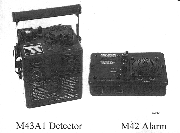
Since the first use of chemical agents in World War I, US military forces have needed a chemical agent detection and warning system. During World War I, many chemical attacks succeeded because troops were unaware of the use of chemicals during battle, had not trained for chemical attacks, and did not possess a chemical detection or warning capability other than their own senses.[1] In 1919, General of the Armies, John J. Pershing, warned that, "Whether or not gas will be employed in future wars is a matter of conjecture, but the effect is so deadly to the unprepared that we can never afford to neglect the question."[2]
The US did not begin to develop a chemical agent detection and warning system until the 1950s—finally fielding the M8 Automatic Chemical Agent Alarm in the late 1970s. By the mid-1980s, technological advances prompted the second generation alarm, the M8A1 Alarm System. This became the US military’s primary means of detecting nerve agent vapors and its primary early warning system. Recognizing Iraq might use chemical weapons, US forces used over 12,000 M8A1 Alarm Systems in the Kuwaiti Theater of Operations.[3] Many US forces continue to use the M8A1 Alarm System as their primary warning system and means of detecting nerve agent vapor. In March 1998, the US will start fielding the Automatic Chemical Agent Detector Alarm (ACADA), the next generation of chemical agent detector/alarm.[4]
The purpose of this paper is to provide a basic understanding of the M8A1 Alarm System, its components, how it operates, its capabilities and limitations, and the various causes of false alarms. This paper also provides some eyewitness observations during the Gulf War concerning the use and operation of the M8A1 Alarm System.
The M8A1 Automatic Chemical Agent Alarm system consists of the M43A1 Detector unit, the M42 Alarm unit, and various power supplies. This system is designed to detect only a narrow spectrum of chemical nerve agent vapor or inhalable aerosol (i.e., G series and VX nerve agents); it does not detect riot control, blister, or blood agents. The M8A1 is a remote, continuous air sampling alarm which automatically detects nerve agent vapors and warns personnel with both audible and visual signals.[5] This system uses the principle of ionization to detect the nerve agent vapor and trigger the alarms. Platoon-level units normally operate the M8A1 Alarm System from a stationary ground position—or mounted in backpacks or on vehicles. Base-level Civil Engineering (CE) Readiness Flight personnel operate the M8A1 for the Air Force. Depending on wind speed, wind direction, terrain, and tactical situation, units should place this system upwind from the unit’s farthest position(s) to ensure as much advance warning of a chemical attack as possible.[6] Since so much depends on the M8A1 Alarm System’s proper placement, only properly trained operators should place and operate this system.[7] Operators receive proper training through formal classes or a correspondence course (e.g., Army Subcourse CM 7105). Specific details of its battlefield placement will be discussed later in this paper. The Air Force trains equipment operators (CE Readiness personnel) at the Readiness School at Ft. McClellan, AL, at Silver Flag Training sites, and at the CE Readiness Flight level.
Weighing about 14 pounds (including batteries), the M8A1 Alarm System consists of two major components: the M43A1 Detector unit and the M42 Alarm unit (See Figure 1). The M43A1 Detector unit senses the presence of nerve agent vapor and sounds an alarm (which has an adjustable volume). The M42 Alarm unit, when connected to the M43A1 Detector unit by wire (e.g., telephone cable), provides a remote audible and visual signal (or visual signal only—a flashing red light) whenever the Detector unit senses nerve agent vapor. As many as five Alarm units can be connected to one Detector unit (Figure 2), enabling more personnel to hear or see the alarm. When linked to the Detector unit, all M42s alarm simultaneously. Specific details of this system’s placement will be discussed in more detail later in this paper.
Figure 1. M8A1 Automatic Chemical Agent Alarm[9]
Figure 2. Five M42 Alarm Units Connected to an M43A1 Detector Unit [10]
Additional Required Equipment[11]
The basic system also includes various power supplies to operate the overall system and its individual units, as well as support equipment:
Power Supplies
Support Equipment
| First Page | Prev Page | Next Page |